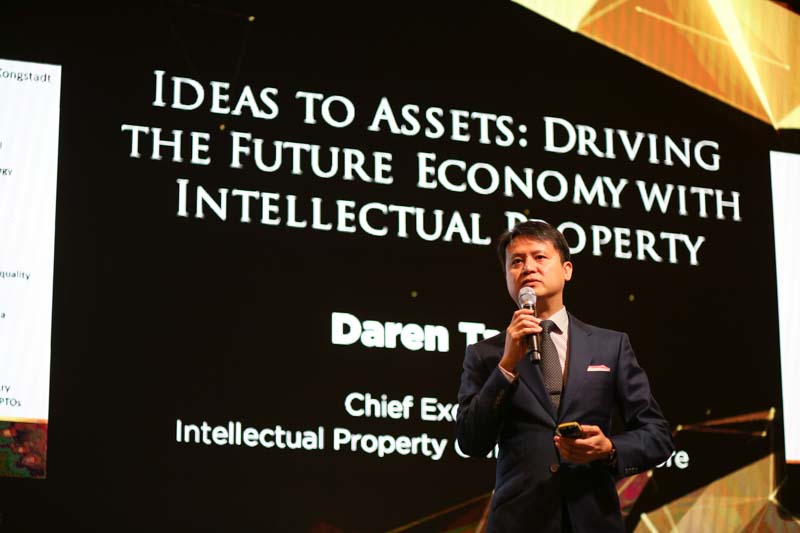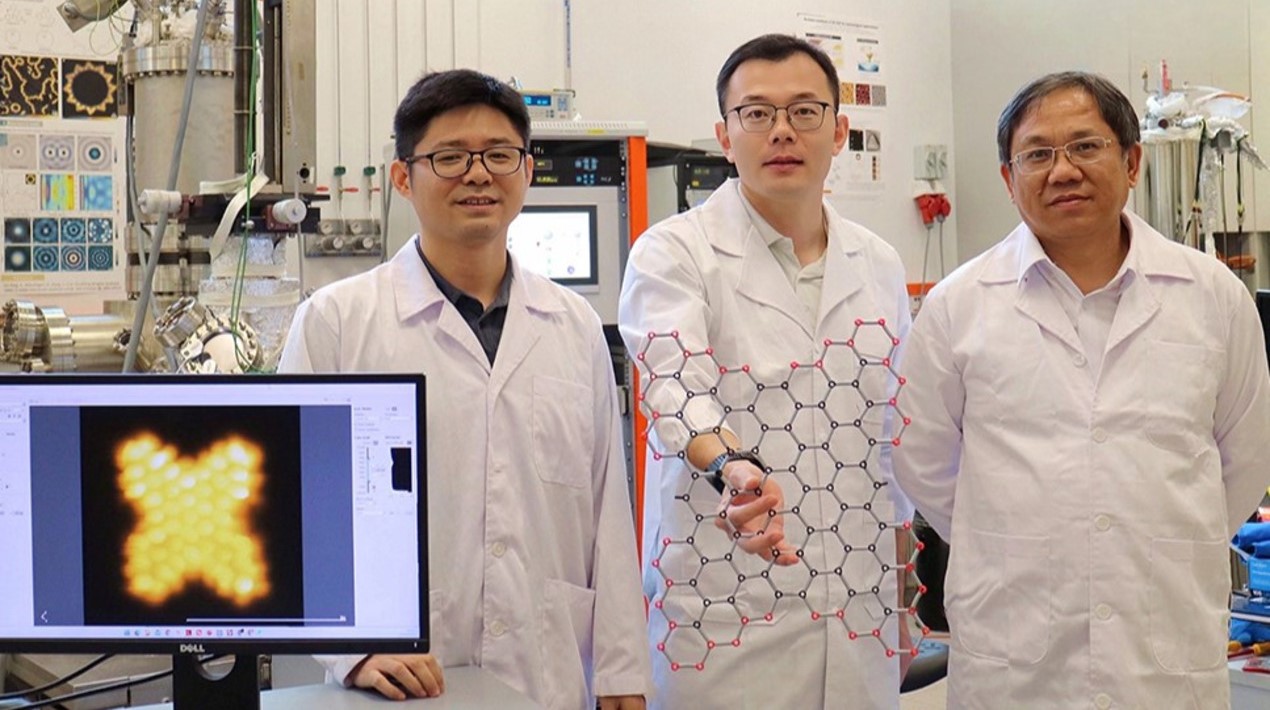
Featured photo: Mr. Daren Tang speaking at the opening of the IP Week@SG 2017 conference on August 31, 2017. Photo: Dean Koh/OpenGov Asia
The Intellectual Property Office of Singapore (IPOS) is a statutory board under the Ministry of Law. While being a registry and regulator of Singapore’s Intellectual Property (IP) remains one of the key roles of IPOS, the organisation is also actively being a builder and facilitator of innovation in recent times, leveraging on its IP expertise and networks to drive Singapore’s growth in the digital economy.
OpenGov had the opportunity to learn from Mr. Daren Tang, Chief Executive of IPOS as he shares about IPOS’s role in Singapore’s bid to become a Smart Nation, thoughts on the IP ecosystem in Singapore as well IPOS’s work with other agencies and organisations in building a vibrant IP ecosystem. Mr. Tang took over as Chief Executive of IPOS in 2015 after serving as the Deputy Chief Executive since 2012 and is the current Chairman of the World Intellectual Property Organisation (WIPO) Standing Committee on Copyright and Related Rights (SCCR).
Could you tell us more about your role as the CEO of IPOS?
Just as Singapore’s economy is transforming, IPOS is also evolving from a registry and regulator to a builder of our innovation ecosystem. My job is to lead and guide the IPOS team as we undergo this journey, so our deep IP knowledge and extensive networks can be deployed to help our enterprises take their ideas to the market. More broadly, we are hoping to change mindsets in Singapore about IP, and to share that IP is not just a legal right but a strategic business asset for the future enterprises and our economy.
We are going to do this in several ways. Let me share just three with you:
a) Reduced filing fees for brand and technology protection
In this competitive economic environment, many businesses are watching their costs very closely. Starting from 1 April 2017, we reduced filing fees by up to 30% for businesses and entrepreneurs who want to protect their brands and technology through the trade mark and patent systems. We were able to do this by becoming more efficient in our internal processes, including through heavy reliance on IT, and passing on the costs savings to our customers. In this way, we can make IP protection more affordable, especially for start-ups.
b) Access to IP consultancy services
We believe strongly that IP brings value only when it is put into an enterprise that can translate that IP into products and services that the market wants. Too often, companies see IP as an output, and not as an input into business growth. Our subsidiary, IP Value Lab, is rapidly building up expertise in IP management and strategy and since the beginning of the year has been engaging with enterprises one-on-one to assist them in identifying and growing their intangible assets as part of the overall business strategy.
c) Access to smart and patient capital for innovation-driven companies
Singapore has built a vibrant start-up scene, but there is a need to ensure that these start-ups have the support to grow into the unicorns of tomorrow. IPOS and partner Makara Capital launched a one-billion dollar Makara Innovation Fund (MIF) in April 2017. Given Singapore’s vibrant start-up ecosystem, the MIF will focus instead on late-stage start-ups, as well as SMEs, that have a proven track record and are seeking to grow internationally. IPOS brings a technical understanding of innovation to the mix whilst the MIF provides experience in building and growing enterprises. The MIF will hunt globally as well as locally, using Singapore as a node to connect innovative companies to regional markets.
What is the function of IP in a digital economy? What role(s) do you see IPOS playing in Singapore’s bid to become a Smart Nation?
The digitalisation of our companies and economy as we drive towards a Smart Nation will fundamentally change what is valuable in our companies.
In 1975, the value of intangible assets in the S&P500 was at about 20%. In 2015, that stood at over 80% – a complete reversal. Singapore and Asia is where the US stood at 1975 and we are at the threshold of major changes to our companies and the economy that will shift enterprise value strongly into intangible assets such as brands, content, proprietary technologies, data and platforms. Already, in the Shenzhen stock exchange, 42% of the SZSE 100 index have intangible assets exceeding 80%.
With these changes before us, it is crucial that our companies know how to identify, value their intangible assets and use it to grow their business. Actually, the tech community has many successful examples to draw on from other countries, such as Facebook, Apple and Amazon, but need not look further than local companies such as Razer to understand how enterprise value will change as our economy transforms.
IPOS is attempting to contribute to this at several levels.
At the company level, our subsidiary – IP Value Lab – has developed products and tools to help our companies better understand their intangible assets and to manage it, including an IP audit and strategy that is supported by SPRING Singapore and for which up to 70% of the costs can be subsidised.
At the regime level, we are constantly amending our laws to support broader trends like digitalisation. For example, with effect from 30 October 2017, our Registered Designs Act has been amended to allow the protection of virtual designs e.g. virtual keyboards, which will be an increasingly important business strategy for tech companies as we move into augmented reality. Last year, we clarified that the “look and feel” of mobile apps can be protected under the Registered Designs regime. We continue to allow for the patenting of
software in certain circumstances where there is a clear innovation, similar to the position in the European Union. With this, we hope that our IP laws and regulations will support our entrepreneurs and innovators.
What are the biggest strengths and areas for improvement in the IP ecosystem in Singapore?
In a nutshell, Singapore has done well in building research capabilities and generating new ideas but the challenge is to make sure that these are transformed into assets and enterprises that are valued by the market and bring value to Singapore.
Our R&D ecosystem is going from strength to strength, and we are midway through the Research, Innovation and Enterprise (RIE) 2020 plan. Thanks to this initiative, which builds on a longstanding commitment to build a R&D sector in Singapore, we are already positioned within the top in global innovation rankings such as Global Innovation Index (GII) and the Bloomberg Innovation Index (BII)[1]. Local research institutes such as A*STAR, NTU and NUS are also amongst the top filers of patents in Singapore, and locally grown brands like SIA, Raffles, Tiger and Razer are world-renowned and command strong valuations.
If we combine our R&D sector with our status as one of the world’s leading financial centres, our world-class legal and business environment, our high level of professional expertise, and the growth of our start-up sector, we should be in a good position going ahead to translate our ideas into assets and enterprises. However, the ingredients that are already present in our country and have been focused on other models of economic growth will now need to be aligned towards innovation.
Recently IPOS and Makara Capital launched a billion-dollar innovation fund. Can you tell us about the about the drivers behind the launch and the plans for the fund going forward?
We saw two challenges regarding innovation in Asia and that gave rise to the idea of an innovation fund.
The first is how our economies can support innovation that needs to go into markets. When start-ups and innovation-driven enterprises are scaling up, they need access to capital and markets. In Asia, there is no lack of growth funds, but they tend to be concentrated in the early and mature stages, leaving a gap in the middle,
and especially in the B to D rounds. Moreover, Asian funds still tend to be focused on the more traditional investment themes like infrastructure, resources and property, rather than on innovation.
The second is how to use IP to drive economic growth and prosperity. While there has been a tremendous growth in the number of IP filings in Asia, that must translate into actual economic and social impact. This is why IPOS has broadened its focus to include IP commercialisation, and our energies will be on helping our companies use IP to drive enterprise growth.
With these in mind, IPOS collaborated with private equity firm, Makara Capital, to design the Makara Innovation Fund (MIF) that will provide 10 to 15 high growth potential companies with smart and patient capital, as well as connection with the relevant networks and expertise, for growth and expansion through IP.
We hope to see more financing options in Singapore for innovative enterprises, and we welcome the chance to work with other financiers who share our perspective of using IP as a strategy for enterprise growth.
Some gaps and opportunities were identified during the year-long consultation in 2016 by IPOS to find out more about role of IP in the innovation cycle. One of the gaps is the lack of coordination among agencies to support innovative companies. How is IPOS working with other public agencies to address this gap?
Innovation is not an easy strategy to implement because it has different characteristics from other economic strategies that we have implemented successfully in the past. Some studies on innovation indicate that a key factor for what makes innovation work in certain places seems to be the presence of a strong network where ideas, capital, expertise and communications flow easily. Within government, IPOS has been working with many other partners to create and strengthen this network effect. For example, we have been working closely with the technology transfer offices in our various research institutes to build a
sense of community and collaboration across these agencies.
As another example, IP Valuelab, IPOS’ enterprise engagement arm, is working closely with economic agencies like SPRING to help companies unlock the value of their intangible assets through schemes like the Collaborative Industry Projects grant for qualifying companies.
We are also working with public agencies such as NRF, A*STAR and many others who are involved in managing research projects or driving innovation in their respective fields to revise our National IP Protocol, which lays down guidelines on how government agencies should manage government IP. The new Protocol makes it clear that agencies should focus on IP commercialisation, but equally importantly, build a community of IP practitioners within government who can share best practices, undergo training and become experts in helping their IP create genuine market impact.
IP has been identified as a key driver of economic growth in the Committee of Future Economy (CFE) Report and the 2013 IP Hub Master Plan has been updated to support the CFE’s recommendation to strengthen Singapore’s innovation ecosystem and build capabilities to help enterprises innovate and scale up. There is a plan to increase IP jobs from 500 to 1000 in the next 5 years. What are some of initiatives in place to both attract new talent and reskill existing professionals in the IP industry?
One of the recurring themes in our conversations with stakeholders is the lack of deep IP expertise in Singapore and Asia. This affects the ability of our companies to commercialise their IP. On the flipside, individuals see IP as a sunrise industry and want to know how to get into it. It does not hurt that IP jobs pay 30% more!
We believe that a highly skilled IP professional who has strong technical knowledge and acute commercial acumen will be able to bring immense value to any enterprise whose business model is centred around technology, brands, designs or content. Our subsidiary, the IP Academy, will step up to provide training and executive education courses ranging from half-day seminars to full diplomas in all types of skills relating to IP and innovation management.
Some progress has already been made on this front. For example, in March 2017, IPOS and Workforce Singapore launched a new IP Professional Conversion Programme (IP-PCP) where mid-career professionals can upskill and acquire the necessary skillsets to take on high value careers in IP and innovation. This $2.2 million programme provides course fee and salary support to train individuals so that they can support businesses in the translation of their innovations and creations into products and assets.
A key programme under the IP-PCP is Singapore’s first Master of IP and Innovation Management programme that we launched with the Singapore University of Social Sciences. This course, which recently saw its first intake of 16 students, is tailored for working adults who will remain gainfully employed throughout the course. The value and differentiating factor that the programme delivers is in the curriculum that focuses on practice and skills through case studies and solving real problems, rather than just knowledge transfer.
As we grow our innovation and IP ecosystem, we look forward to working with other professional associations, academies and institutions of higher learning to develop a pipeline of such talents to meet the growing manpower needs in this area.
You were appointed as Chairman of the World Intellectual Property Organisation (WIPO) Standing Committee on Copyright and Related Rights (SCCR) in May this year. Could you tell us about the experience so far and how you see Singapore contributing to the global copyright system?
Copyright controls the creation, flow and consumption of content and knowledge. It has become one the most hotly debated areas of IP because this is an area where technology has massively disrupted old business models – just think of Netflix, YouTube, Spotify and iTunes – but the dust has yet to settle on what could be new and sustainable business models. It has also become highly controversial, because access to content and knowledge has now become key to our lives and fundamental to the functioning of many societal institutions, schools, museums, archives, libraries, to name a few.
Imagine therefore sitting in a cavernous hall filled with hundreds of negotiators from all over the world trying to build consensus on various issues that are highly technical but have an impact on our citizens and whole industries, and you have an inkling on what challenges my fellow negotiators and I face at these discussions….
Given these, it is a deep honour for me to have been elected as Chair by my fellow WIPO member states and I hope to fly Singapore’s flag high not just by being a technically credible chair, but as someone who can help bridge differences between countries, regions, industries and stakeholders. Ultimately, I hope that being the Chair will help Singapore make more friends, build more connections and remain even more relevant to the international community.
[1] Singapore is ranked 7th most innovative globally, and 1st in Asia by the GII 2017. For BII 2017, Singapore is ranked 6th globally.


















